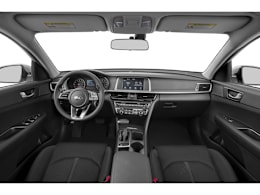The Optima is very competitive among mid-sized sedans thanks to its roomy interior, easy to use controls and competent performance but it tends to fly under the radar.
It's more eye-catching than other mid-sized sedans, but less popular than the safe-bet Toyota Camry and Honda Accord. The Optima is also loaded with standard and smartly priced optional features that you feel like you got more than you paid for.
The smooth 185-hp, 2.4-liter four-cylinder is mated to a quick-shifting six-speed automatic transmission. Its 8-second 0-to-60 mph time is adequate but fuel economy is 28 mpg overall, whereas a few competitors get 30 mpg or more.
Handling is responsive and the car remains under control even when pushed to its limits. There's a firmness to the Optima's ride that makes the car tight and controlled but it lacks the plushness of say a Toyota Camry. In addition, tire noise becomes noticeable on coarse pavement. The brake pedal has a firm feel, and the Optima has a shorter stopping distance than many competitors have.
Understated competence reigns inside. Its large door openings make it easy to get in and out, and the wide and supportive leather driver's seat is tearoom plush, complete with four-way power lumbar adjustment.
The Kia has a sloping, tapered roofline that mimics the shape of other trendy, modern sedans. Such a silhouette can make rear seats seem claustrophobic, but the Optima's commodious cabin has plenty of room.
The array of infotainment and climate controls is well-placed and easy to use, with a businesslike arrangement of familiar knobs and buttons.
Not that everything is perfect. The low dash vents are more likely to freeze your elbow than cool your face.
Advanced safety features, which include forward collision warning, lane keep assist, and blind spot with rear cross-traffic warning, are now standard equipment across all trims.
Overall, the Optima offers an enjoyable driving experience, with substance and value.


























